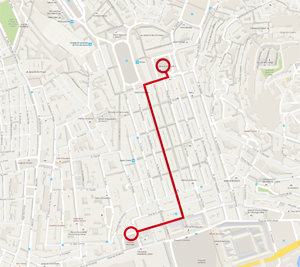

| Home | Aims and Scope | Organisation | Presentations | Programme | Technical Visit | Contacts | Extended Abstracts |
| Technical Visit | |
Your itinerary is marked in red  |
ENGLISH Subway: Rossio station (Green Line) or Baixa-Chiado station (Blue Line) Exhibition Lisbon (Re) Foundations
|
During the refurbishment of the Headquarters of the Bank of Portugal, an archaeological excavation was carried out in the ancient church of São Julião and in some accessible areas of the other headquarters buildings. Several findings were made. Modern level: One of the most emblematic findings, although expected, were the wood poles of the Pombaline period, located particularly on the foundations and on the supporting walls. This foundation structure (composed of wood poles and grids) is linked to the reconstruction efforts of the city following the 1755 earthquake. At the end of the visit, you can also visit the Interpretation Centre for the Wall of D. Dinis. (Back to Rua do Comércio, straight forward to Rua Augusta, turn left to Rua dos Correeiros) Millennium bcp Foundation - Archaeological Centre (NARC) Near the arch in Rua Augusta occupying almost an entire block in the Pombaline historical centre of Lisbon, stands the Millennium bcp building. |
|
